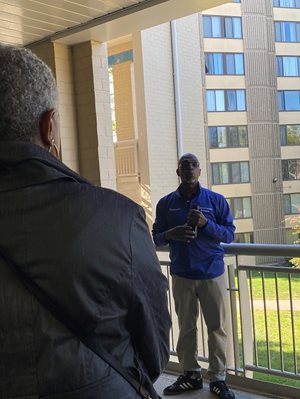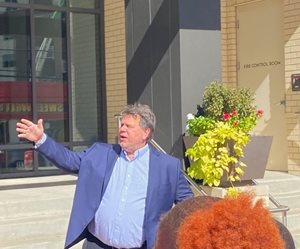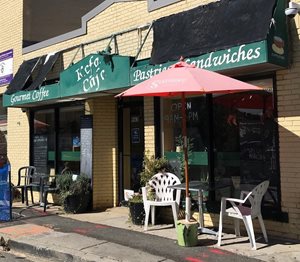 NeighborWorks America staff joined policy leaders from Enterprise Community Partners to visit properties near Washington, D.C., a way to foster understanding of the different challenges — and achievements — of affordable housing and community development organizations.
NeighborWorks America staff joined policy leaders from Enterprise Community Partners to visit properties near Washington, D.C., a way to foster understanding of the different challenges — and achievements — of affordable housing and community development organizations.
The tour began at Edgewood Commons, a former NeighborWorks network organization now in partnership with Enterprise. Staff say the property is an oasis in a Washington, D.C., neighborhood that was once referred to, disparagingly, as "Little Iraq."
"We try to serve residents at every stage of the spectrum," said Martin Taylor, regional resident services coordinator. It took years, but the campus for the development now includes housing for both families and individuals, computer rooms, a childcare center and recreation space. Along with residences for adults 62 and older, the site houses offices for a group from National Institutes of Health, which surveys residents and offers diagnostic services.
"Tours like this are a great way for staff to get out to experience our mission," says Tamar Greenspan, senior director of policy for NeighborWorks' Public Policy and Legislative Affairs Division, which organized the event. "It's important for all of us, and especially for folks in inward-facing roles, to have opportunities to connect the dots between the work that NeighborWorks America does and the real people, homes and communities that we and our network organizations serve."

Staff also visited The Bonifant, a property that NeighborWorks network organization Montgomery Housing Partnership (MHP) built adjacent to Silver Spring's new public library and under-construction purple line. The purple line, comprising 16 miles of light rail, was initially set to open in 2022. That projection has been pushed back to 2027. Meanwhile, organizations are working to protect affordable homes that could become not-so-affordable with new access to public transit.
Robert Goldman, executive director of MHP, said his organization wants to not just improve affordable housing, but to "preserve as much affordable housing as we can" as the purple line is established. The idea of a development at that spot dates back to when Goldman first started at the organization 22 years ago. The property, which contains 149 apartment homes for residents 62 and older, is largely affordable housing, with a small percentage leased to residents at market rate.
The building includes lots of kitchen and gathering spaces. "Building community space is very important to us," Goldman explains.
 Meanwhile, organizations also work to help independent shops and restaurants trying to stay afloat during purple-line construction. Which can make it look like nobody is open for business. Sheila Somashekhar, executive director of the Purple Line Corridor Coalition, says it's important to ensure that housing stays affordable as well as spaces for businesses, many of them owned by immigrants. "We want to make sure we're thinking of transit impact beyond the tracks."
Meanwhile, organizations also work to help independent shops and restaurants trying to stay afloat during purple-line construction. Which can make it look like nobody is open for business. Sheila Somashekhar, executive director of the Purple Line Corridor Coalition, says it's important to ensure that housing stays affordable as well as spaces for businesses, many of them owned by immigrants. "We want to make sure we're thinking of transit impact beyond the tracks."

